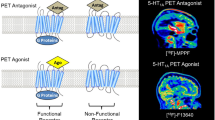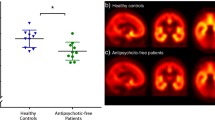Abstract
With a decade of neuroreceptor imaging of antipsychotics behind us, this article attempts to synthesise what has been learnt about the mechanism of action of antipsychotics using these techniques. The data show that: (i) the ‘typical’ antipsychotics bind mainly to the dopamine D2 receptor, and that 60–80% D2 occupancy may provide optimal antipsychotic response with little extrapyramidal side effects; (ii) all the clinically available ‘atypical’ antipsychotics show a higher occupancy of the 5-HT2 than D2 receptors; (iii) however, these ‘atypical’ antipsychotics differ in their D2 occupancy. The D2 occupancy of risperidone is within the typical range (ie > 60%) while that of clozapine is clearly lower (<60%); (iv) antipsychotics with combined 5-ht2/D2 antagonism lose some of their ‘atypical’ properties if used in doses where their D2 occupancy is too high (>80%). Based on these data a framework is suggested wherein antipsychotics may be classified on the basis of their D2 and 5-HT2 occupancy in patients at steady state while taking clinically relevant doses. Within this framework typical antipsychotics are classified as ‘high-D2’, risperidone as ‘high-D2 high-5HT2’ and clozapine as a ‘low-D2 high-5HT2’ antipsychotic. The justification, limitations and the value of this framework in understanding and investigating newer antipsychotics is discussed.
This is a preview of subscription content, access via your institution
Access options
Subscribe to this journal
Receive 12 print issues and online access
$259.00 per year
only $21.58 per issue
Buy this article
- Purchase on Springer Link
- Instant access to full article PDF
Prices may be subject to local taxes which are calculated during checkout
Similar content being viewed by others
Author information
Authors and Affiliations
Rights and permissions
About this article
Cite this article
Kapur, S. A new framework for investigating antipsychotic action in humans: lessons from PET imaging. Mol Psychiatry 3, 135–140 (1998). https://doi.org/10.1038/sj.mp.4000327
Received:
Accepted:
Published:
Issue Date:
DOI: https://doi.org/10.1038/sj.mp.4000327
Keywords
This article is cited by
-
Beyond Clinical Remission in First Episode Psychosis: Thoughts on Antipsychotic Maintenance vs. Guided Discontinuation in the Functional Recovery Era
CNS Drugs (2016)
-
New insights on the neuroanatomy of schizophrenia
Current Psychiatry Reports (1999)



